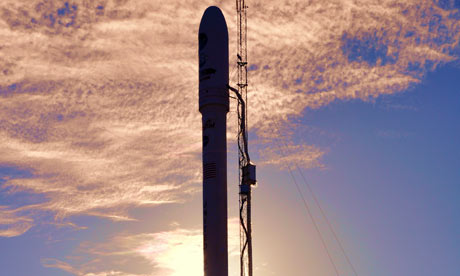
A sunset silhouette of the Taurus XL rocket with Nasa's OCO satellite aboard sits poised for launch at Vandenberg Air Force Base in California. Photograph: Analex Randy Beaudoin/Nasa
Nasa's pioneering satellite, designed to map carbon dioxide concentrations, has crashed into the ocean near Antarctica after running into technical difficulties during launch earlier today.
The Orbiting Carbon Observatory (Oco) blasted off in the early hours of this morning aboard a Taurus XL rocket from Vandenberg Air Force Base in California. However, at 10.11am GMT, as the satellite prepared to separate from the launch vehicle, Nasa launch director Chuck Dovale "asked that the contingency plan be implemented".
Three minutes later an explanation came through on the satellite's launch blog: "According to Nasa commentator George Diller, the payload fairing failed to separate from the vehicle during ascent." The 160 centimetre-wide payload fairing is the nose cone that protects the satellite as it blasts through the atmosphere and should have split in two before falling away from the satellite. Because of the additional weight of the fairing, the rocket and satellite failed to reach orbit and subsequently plummeted into the Southern Ocean.
The remains of the satellite are unlikely to be recoverable, said a Nasa spokesman: "I'm not sure there'll be much of the satellite left." He added that fairing failures are not a regular occurrence.
"Certainly for the science community it's a huge disappointment," said John Brunschwyler, Taurus project manager for Orbital Sciences Corp, which built the rocket and satellite. "It's taken so long to get here." The project took nine years to reach the launch pad.
"The loss of this instrument is a serious setback," added Professor John Burrows, a co-investigator for the satellite. "Oco planned to build on the first measurements by the European Sciamachy instrument on Envisat and is complementary to the recently launched Japanese mission, Gosat." The technology onboard Oco was unique and boasted the ability to take more frequent and sensitive readings of CO2 levels than Envisat and Gosat.
Nasa's director of Earth sciences, Michael Freilich, said: "Over the next several days, weeks and months, we're going to carefully evaluate how to move forward and advance the science, given our evaluation of the assets that are in orbit now, the assets of our international partners and the existence of flight spares in order to put together a programme, as rapidly as possible, to pick up where Oco left off."
The £190m satellite was designed to collect precise measurements of the greenhouse gas in the Earth's atmosphere, identifying where it is being emitted, where it being absorbed and what happens to it in between.
"It's critical that we understand the processes controlling carbon dioxide in our atmosphere today so we can predict how fast it will build up in the future and how quickly we'll have to adapt to climate change," said David Crisp, principal investigator for the Oco based at Nasa's Jet Propulsion Laboratory in Pasadena, California.
Experts believe a successor to Oco is likely. "Given its relatively low cost, I would expect a second Oco to be approved," said Dr Chris Welch, principal lecturer in Astronautics at Kingston University's Faculty of Engineering.

No comments:
Post a Comment